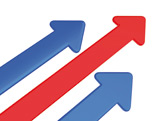 The latest mortgage index from John Charcol suggests that the recent sharp increase in the proportion of borrowers choosing a fixed rate has been reversed.
The latest mortgage index from John Charcol suggests that the recent sharp increase in the proportion of borrowers choosing a fixed rate has been reversed.
Between September of last year and February of this year the proportion of John Charcol clients choosing a fixed rate more than doubled, but this trend was reversed in March, resulting in virtually a 50/50 split between fixed and variable rates. Ray Boulger, senior technical manager at John Charcol, commented on this and other findings.
“In March 2010, exactly one year after the historic cut in Bank Rate to an all time low of 0.5 per cent, just 17 per cent of our clients chose a fixed rate mortgage. The proportion then started increasing as the cost of fixed rates fell, reducing the premium one had to pay for security, and as people started worrying about rate increases. With the cost of fixed rates bottoming out around the turn of the year and increasing worries about a rate rise as a result of the surging CPI, fixed rate take up jumped sharply from 32.2 per cent in December to 56.0 per cent in February. In March this figure fell to 49.9 per cent as borrowers were put off fixed rates by the hike in price.
“Looking ahead, the fall in year on year CPI in March has taken some pressure off the MPC and as CPI increased by 0.6 per cent in April last year any increase of less than that this month will result in a further fall in the April year on year figure. That said, in the following 3 months it will be more of a challenge for CPI to continue falling as the previous year’s figure which will fall out of the year on year calculations will be + 0.2 per cent, +0.1 and -0.2 per cent.
“Despite the probability that CPI will remain well above the target 2 per cent for at least another year there are plenty of reasons to expect our economic growth to remain weak and the first estimate of 2011 Q1 GDP figures on 27 April will be a key factor influencing Bank Rate decisions for the next few months. Another negative number, or even one that only just scrapes into positive territory, would significantly increase the likelihood of Bank Rate still being at 0.5 per cent at the end of the year.”



